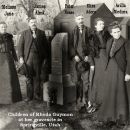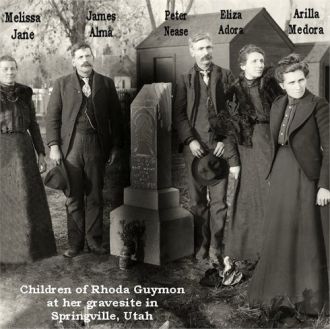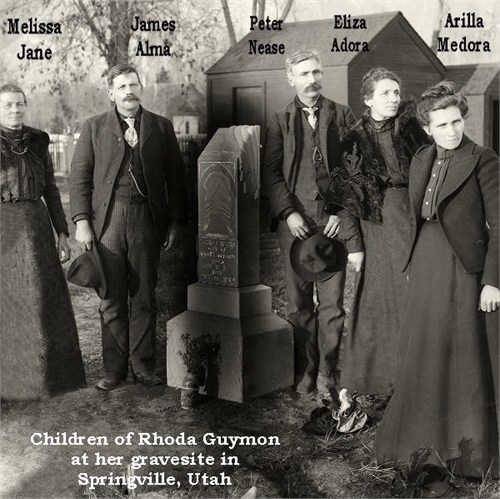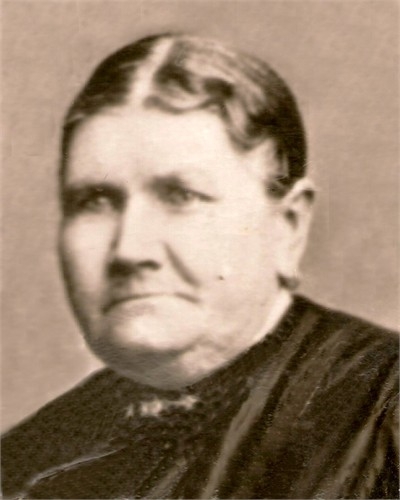Rhoda Leach Nease Guymon
A photo of Rhoda Leach Nease Guymon by Her Granddaughter, Kate Noakes Gibby Snow
Rhoda Leech Nease, born April 2, 1830 in Leechburg, Armstrong County, Pennsylvania. She was the first white child born in Leechburg. She had Blue eyes and dark hair. The man who donated the ground for the town site of Leechburg and his wife were a childless couple. They wanted to adopt my grandmother Rhoda Leech Nease. She lived with them for some time but when Rhoda’s parents joined the Mormon Church they would not give her up. Mister Leech was a wealthy man and left a considerable amount of money to Rhoda in his will. This has never been collected and was published in a magazine several years afterward but they said it was outlawed and was turned back to the state.
Her parents with their family of five children were living in Nauvoo, Illinois in 1843. Her father names was Peter Nease, tradition is that her was born in Glasgow Scotland and ran away from home as a young boy becoming a sailor, spending many years at sea and ending up in Pennsylvania. This is where he met her mother Lucinda Ellen Martin. They were married in 1821 and had eight children; Rhoda was the fifth child in the family. Lucinda’s parents were Daniel Martin and Katie Ann Grimes.
During the heavy persecution in Nauvoo a mob came thru town and burned the homes of the saints. Peter Nease was a sailor and away from home on a trip when the mob came thru. When the mob came to the Nease home they found Lucinda sick in bed, they drove the children outside and drug the Lucinda out on her feather bed and burned the home to the ground. From shock and exposure Lucinda died, the children were then taken into separate homes.When her father Peter Nease returned to Nauvoo from his trip he was not able to stand the shock of what her found and not being very well either, he died leaving the five children orphans. Three of his children had died in childhood. Rhoda was thirteen at the time and taken into different people’s homes to help them for her board.
She left Nauvoo with the saints and in Winter Quarters or Council Bluffs she met James Guymon. His wife was an invalid with three children. She married him in polygamy and she and his other wife Mary Ann Couch were sealed to him as Plural wives on Mar 13, 1847, just before Rhoda’s seventeenth birthday. She was very helpful to his invalid wife and helped to raise her three children. Rhoda’s eldest son, Heber Guymon was born Jan 24, 1848. They were then living in Kainesville Iowa. James Guymon had been assigned to raise crops for the saints there. When it came time for volunteers for the Mormon Battalion grandfather could not go but he outfitted a man named Looper to go in his place.
In June of 1849 they all started across the plains for Salt Lake City. There were seven in the family, Mary Ann Couch and her two children, Synthelia Guymon a child of his dead fist wife Sarah Davis who had died in childbirth, along with Rhoda and her little son Heber. Heber road all the way in a little chair called the Nauvoo chair, which is still preserved with other family relics. They started with three yokes of oxen and cows and two wagons. Mary Ann took the Cholera for the second time after they had been gone only a few days. I t was considered fatal but James called his family in the Prairie Schooner and administered to her and she instantly healed. They traveled with the Willard Richards Company. William Huntington was captain of the ten and James Guymon was appointed hunter of the ten.
His oldest son, Lafayette Guymon who was only nine years old at the time remembers his father riding into camp with an antelope thrown over his shoulder and his long black hair flying in the wind. He could pick out a favorite young buffalo and kill it by shooting it in the head which was a very difficult thing to do. Sometimes they were compelled to stop and form a circle with their wagons with the oxen inside the circle while great herds of buffalo passed by. At time the herd was so large they were held for half a day. This was a very difficult trip for my grandmother as she was expecting her second child. When the time came they drove off to one side on the banks of the Platt River, their little son Brigham was born on September 9, 1849. They stayed a few days until they thought Rhoda was able to travel. She was so sick that when they came to Fort Bridges in Wyoming they stayed for two weeks.
When they were about one hundred miles from Salt Lake City they camped with The George A. Smith Company. Such a heavy snow fell during the night that they had to dig their wagons out. They found that the pig they had hauled all the way from Kainesville had frozen to death. Just a little while before they arrived in Salt Lake City James took the mountain fever and it stayed with him the forepart of the winter. They arrived in Salt Lake City on October 9, 1849 and the two families stayed together in a one room pole house, that first winter. Grandmother's baby Brigham Guymon died on December 27, 1849. One can make a mental picture of the process of living under these conditions. The beds were on the floor and the effort to keep everything clean and the sick comfortable. The leaky roof and the preparation of meals over a little rock fireplace in the corner, and a general lack of provisions.
The noise of seven people in one room was where grandmother learned patience. Surely the Lord was with them to keep them from despair. During this time grandmother’s brother in law Jefferson Hunt, came from California where he had made quite a stake and he gave the money in twenty dollar gold pieces. He also gave grandmother a beautiful pair of earrings she treasured all her life.
In the spring they settled in Murray or little Cotton wood. They saved their crop of grain from crickets by fighting very hard. The following spring they were called to Lehi to help build it up. They raised a wonderful crop of grain on the old Indian trail only to have it demolished by the Indians when they started to migrate and all of them trailed across it. So they moved to settle in Springville where they were going to make their home. James Guymon was then called by Brigham Young to take his family down to Parowan County to help strengthen the place as the Indians were giving them so much trouble. Grandmother now had two more babies and they had to trade their lovely farm in Springville for one in Parowan County.
They lost the first crop to the crickets and were saved only from starvation by a man Irwin Stewart who had stored some grain and sold it for a peck on the bushel (this meant that when they came to settle for the grain they gave back five pecks instead of four). This wintered they through and gave them seed for the next planting.
They endured many hardships in Parowan, but James Guymon helped to build up the town. He built walls around the town to keep the Indians out, fences and public building and all that was necessary to build up a city. Grandmother had five more children in the twelve years they stayed in Parowan. Grandfather made trips occasionally about once a year to Salt Lake City. He took a load of grain and traded it for leather which he used to make their shoes. He made the shoes for the whole family and Grandmother and the older children raised sheep and corded the wool, spun and wove the cloth for all the clothing they had. On one of these trips at conference time the authorities asked him to take an English girl who had been stranded here expecting to marry her English lover here. It was advised by the leaders of the church for the brethren to marry these girls so they would not take up with the solders and other men who were just passing thru Salt Lake City.
James Guymon married Mary Boden on October 8, 1857 and took her back with him to Parowan. She had two trunks of fine silks and cloth and she was a good seamstress so she made dresses for all of them. She lived with Mary Ann Couch and helped her as she was still an invalid. After twelve years Grandfather’s mission was up and they moved to Fountain Green, San Pete County. Mary Ann Couch stayed in Parowan with her daughter who had married. Grandmother and Mary Boden along with her three children moved to Fountain Green. Grandmother had three more little girls in Fountain Green my mother Amilla Ann Guymon being the eldest.
Grandfath er married two more wives in Fountain Green and raised large families by them. He had thirty three children in all, and Grandmother had twelve of those children. Each of his wives had a home of her own with a cow, chickens, apple orchard, garden and a few sheep to make their clothes from the wool. Grandfather had a large farm where he raised grain and feed. He would spend a week in each of his wives home and was treated like a king.
Grandmothe' sr home was the largest as she had the most children. This was the place for all family dinners, gatherings and entertainments. The wives and families were all united and loved each other. The young people would gather at her home and Grandfather would play the fiddle and call out the square dances while the young people danced.
Grandfath er was a tall dark handsome man and rode his white horse in the parades where he was usually Captain of the Day. He was a major in the Black Hawk war and looked handsome in his uniform. He had many experience with the Indians who came to respect him. Grandmother was the mother to all the families and each of the wives was a devoted Churchwoman.
Rhod a Leech Nease was a Relief Society Teacher and never failed in her monthly visits and gathering the Sunday eggs and store them for the poor. She always went to take care of the sick in the neighborhood. She was Primary President and her children always talked of how nice she looked when she went to church. She had a fine sense of humor which tided her over many difficult times. She was also very brave and had a lot of faith as was manifest in an Indian story. It was during the Black Hawk War her husband was a Major in the war and her older boys were on guard duty she refused to move with the rest of the families into the small fort that had been made because some of her children had the measles and she was afraid to move them.
That night the Indians came with their war dances and encircled the house many time yelling and crying with bloodcurdling shrieks . They would pick up the bars in the gate and drop them and make all kinds of hideous noises outside the house. She had nothing to protect herself or her children with except her faith and prayers. She knelt with her healthy children around the bed that held the sick little ones and pleaded with our Heavenly Father to call the Indians away and to protect the family from being massacred. She rose from her knees and assured her family that all was well and they would be safe. She then went about the nursing of her sick children safe in her faith. The Indians left and soon everything was peaceful and quiet outside again. The next day she moved into the fort.
She lived a life of noble and sacrificing deeds in her home and community. The church was always first in her way of life she and her husband took an active part in religion and civic affairs. She raised nine sons and daughters to maturity she lost three children in childhood.
W hen the Manifesto was signed her husband was awarded his last wife and they believed in honoring and sustaining the laws of the church. She went to live with her children. She died December 14, 1899 in the home of her daughter Dora Crandall and was buried in Springville. She knew persecutions and sorrow also happiness and joy of overcoming and living a good clean righteous life.
By a loving Granddaughter
Kate Noakes Gibby Snow
Date & Place:
Not specified or unknown.



 Laura Terry
Laura Terry 

